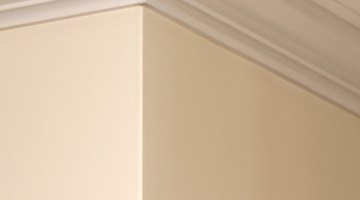Are Popcorn Ceilings Dangerous?
The potentially dangerous type of popcorn ceilings were installed in homes up until the 1980s. The term popcorn ceiling refers to a coating sprayed or brushed onto the ceiling that dries to a textured finish. The coating offers acoustical advantages by muffling sound.

Damaged or uneven ceilings often prompted the application of a popcorn ceiling. The problem with some of these coatings occurs because they contain asbestos. The asbestos only becomes harmful if the ceiling deteriorates or gets damaged.
Identification
Asbestos does not change the look of the ceiling, so you can't tell by looking at the ceiling if it contains asbestos. You also cannot tell by the age. The manufacture of asbestos popcorn ceiling material was banned in 1978. However, the law allowed application of the existing product, so asbestos textured ceilings may have been installed as late as the 1980s. To know for sure, have a professional take a sample for lab analysis.
Risk
The popcorn ceiling only becomes dangerous when it gets damaged, disturbed or begins to deteriorate. Damage allows dust that contains asbestos to float around in the air and possibly get inhaled by unsuspecting residents. Asbestos exposure has been linked to a rare form of cancer called mesothelioma in addition to chronic breathing problems. The risk of having health problems after exposure is unknown; damage does not usually show until years after exposure.
Managing Popcorn Ceilings
If the ceiling remains in good condition, you can safely leave it in place. Attempts at removal can cause more problems than leaving it undisturbed. Inspect the ceiling periodically to assess its condition. Take precautions so that the ceiling will not get damaged by accident. Don't touch it or disturb it in any way even to clean it.
Removal or Repair
If a popcorn ceiling poses a danger because of damage or deterioration, you have a couple of options. Either one should be done by a professional. Repair can involve sealing it so that asbestos fibers remain stable, or enclosing it by placing another material over it. Repair usually costs less than removal. Only a professional can remove an asbestos containing popcorn ceiling. The procedure is complicated and, if done incorrectly, will cause more exposure than leaving it damaged and in place.
The Drip Cap
- The potentially dangerous type of popcorn ceilings were installed in homes up until the 1980s.
- The asbestos only becomes harmful if the ceiling deteriorates or gets damaged.
- Damage allows dust that contains asbestos to float around in the air and possibly get inhaled by unsuspecting residents.
- Attempts at removal can cause more problems than leaving it undisturbed.
- Don't touch it or disturb it in any way even to clean it.
References
Resources
Writer Bio
Kimberly Wilson has been a freelancer since 2009. She also works as a marketing and sales professional. Wilson specializes in mental heath and wellness articles for various websites. She has a Bachelor of Arts in psychology from Syracuse University.
Photo Credits
- Jupiterimages/Photos.com/Getty Images
- Jupiterimages/Photos.com/Getty Images
More Articles



